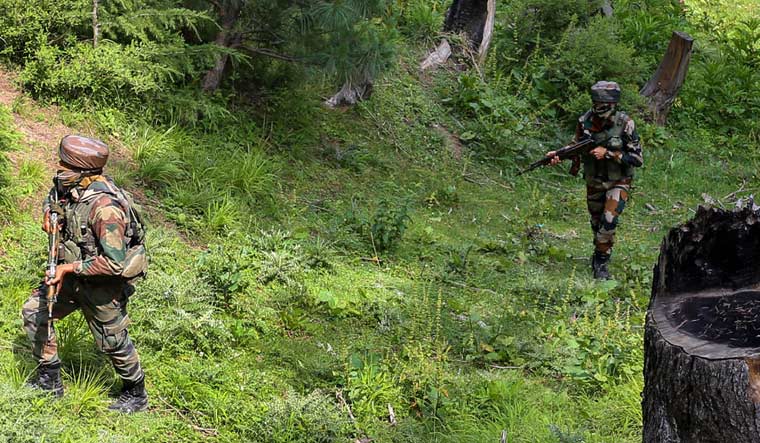Doggedly aiming to inflict as many casualties among security forces as possible, there is an emerging pattern in the way militants are operating in Kashmir.
With the intent of demolishing whatever sign of normalcy has recently set in the disturbed Union Territory after long decades of violence and militancy, the militants are increasingly adopting the tactic of luring the security forces into an area of their own choosing before trapping them with volleys of heavy gun fire.
And in most cases, the area of the encounter is in the hills and forests where militants are already well-entrenched in a vantage position yet with adequate cover from the returning fire. Coming well-prepared to engage, they also position themselves with adequate store of ammunition, weapons and food in preparation for a long gunfight.
As with jungle warfare techniques, the area is also decided on the basis of a secure exit route that is taken by the militants after inflicting maximum possible damage.
That is the reason why the encounter was still on when last reports came in on Thursday.
Another challenge that he security forces are tackling is the lack of chatter or telephonic or electronic conversations between the militants, their network of overground supporters and with their Pakistan-based handlers. This makes it difficult to pinpoint their locations with absolute accuracy.
These are definite changes in tactic after the trend of ‘hybrid’ militants gunning down soft targets including migrant labourers in urban locations of Jammu and Kashmir.
On Wednesday, Colonel Manpreet Singh, the commanding officer of 19 Rashtriya Rifles, his deputy Major Ashish Dhonchak, and Humayun Muzamil Bhat, a deputy superintendent in of police (DSP) were killed in the gunfight in the Gadool forest at Kokernag in Anantnag district.
Reports said the security forces, led by the officers, were climbing up a stiff cliff where the militants had taken positions. So secure were the militants’ positions that they even fired at a helicopter that had flown to the area to pick up the wounded for emergency medical treatment.
The very fact that a colonel, a major and a police DSP have been killed also underlines the fact that Indian security forces officers lead from the front as part of their training which is why they most of the time become the first targets.
The J&K Police’s official handle on X, formerly called Twitter, posted: “… our forces persist with unwavering resolve as they encircle 2 LET terrorists, including Uzair Khan.”
On Thursday, another soldier is reported to have succumbed to his injuries.
A fledgling outfit called The Resistance Front (TRF)— believed by the Indian security agencies to be another front for the Lashkar e Taiba (LeT) as part of their recent name-changing and restyling spree—had claimed responsibility on social media for the attack.
The statement also claimed that the attack was in revenge for the killing of Riyaz Ahmad alias Abu Qasim in Pakistan-occupied Kashmir’s Rawalkote last Friday. Ahmed was shot by unidentified gunmen inside a mosque while offering pre-dawn prayers.
Ahmad was the fourth top militant from Kashmir to be gunned down this year.
On February 14, Aijaz Ahmad Ahangar, alias Abu Usman Al-Kashmiri, a top terrorist of the global terror group Islamic State was shot dead in Kabul in Afghanistan.
On February 26, Syed Khalid Raza, former Al-Badr Mujahideen commander, was killed by unidentified gunmen in Karachi. On March 20, Bashir Ahmad Peer alias Imtiyaz Alam, a top Hizbul Mujahideen commander was killed in a similar manner in Pakistan’s Rawalpindi.



